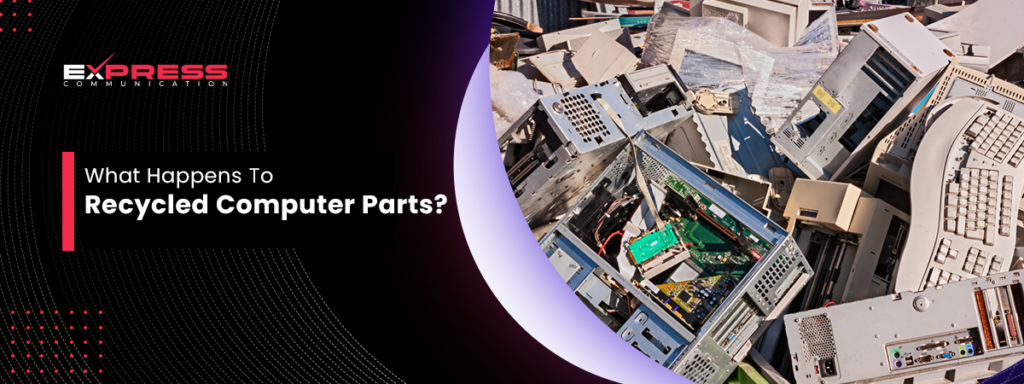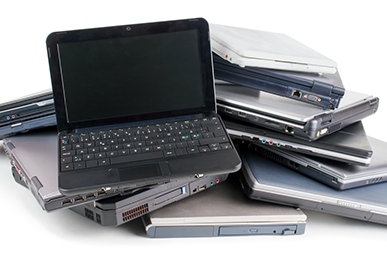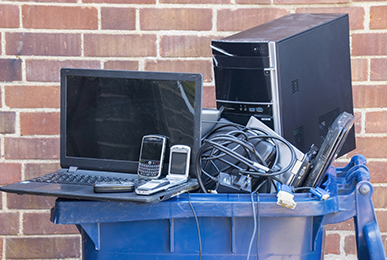
Ever wondered what happens to computer parts once they’re no longer zipping and zooming with data and programs? In a world where technology changes faster than a chameleon changes colors, it’s crucial to think about the afterlife of our electronic buddies. So, let’s dive into the journey of recycled computer parts and discover their destiny!

Table of Contents
The Great Collection
Before we get into the nitty-gritty, let’s talk about how recycled computer parts start their adventure. It all begins when you decide that it’s time for your old computer to retire. Instead of letting it collect dust in a corner, you can take it to a recycling center, where its journey to a new life begins.
1. Drop-off Points and Collection Centers
Imagine a place where all electronics gather, sharing stories of their glory days of streaming movies and crunching numbers. That’s your local electronic recycling drop-off point. Here, recycled computer parts are collected, sorted, and prepared for the next phase of their life.
2. Schools and Businesses: A Treasure Trove of Electronics
Schools and businesses often update their tech gear to keep up with the latest and greatest. These places are gold mines for collecting recycled computer parts. They usually have bins or special programs to ensure their old computers get recycled properly.
The Sorting Saga
Once the recycled computer parts have been collected, they embark on a quest of sorting. This is where the magic begins. Specialists at recycling centers divide the parts into categories: those that can be reused, those that will be refurbished, and those destined for material recovery.
1. Testing and Refurbishing
Some computer parts are like hidden treasures, still full of life and ready for action. These parts are tested to see if they still work. If they pass the test, they might be refurbished, which means they’re cleaned up, fixed up, and prepared to be part of a new device.
2. Material Recovery: A Gold Mine!
For the parts that can’t be brought back to life, there’s still hope. These components are sent on a journey to material recovery, where precious metals like gold, silver, and copper are extracted. It’s like a modern-day treasure hunt!
The Heroes of Management and Recycling: Who Makes It Happen?
Let’s take a moment to appreciate the unsung heroes of the recycled computer parts world. These are the workers at recycling centers, the designers making electronics easier to recycle, and even you when you decide to recycle your old computer.
1. Management and Recycling Centers: The Heart of the Operation
Management and Recycling centers are where the magic happens. They’re equipped with special tools and machines to dismantle, sort, and process recycled computer parts. The workers here have the important job of ensuring each part finds its best next use.
2. Eco-Friendly Designers
Some designers are thinking about the end of a computer’s life even before it’s built. They’re coming up with ways to make computers easier to recycle, using fewer harmful materials and designing them so they can be easily taken apart for recycling.
The Transformation: A New Life for Old Parts
After sorting and processing, recycled computer parts embark on an exciting journey of transformation. This part of their story is all about turning the old into something new and valuable.
1. From Old to Gold: The Rebirth of Components
Some recycled computer parts find new life in refurbished computers. These are systems that have been given a makeover, with functioning parts replacing the faulty ones. It’s like giving an old car a new engine and a fresh coat of paint. These refurbished computers can serve new users at a fraction of the cost of a brand-new one, making technology more accessible to everyone.
2. Material Magic: Creating New from Old
The parts that can’t be reused directly undergo a process called material recovery. Metals, plastics, and other materials are extracted and sent off to become raw materials for new products. This is where your old computer parts could end up in a variety of places – from being part of a new computer or gadget to turning into something completely different, like jewelry or automotive parts. The possibilities are endless, proving that one man’s e-waste is another man’s treasure.
The Environmental Impact: Why Management and Recycling Matters
Management and Recycling computer parts isn’t just about decluttering or making new things. It has a profound impact on our planet.
1. Saving Precious Resources
By recovering and reusing materials from old electronics, we reduce the need to mine new materials. Mining has significant environmental impacts, including habitat destruction and pollution. Recycled computer parts help conserve natural resources and reduce the environmental footprint of new products.
2. Reducing Harmful Waste
Electronics contain hazardous substances like lead, mercury, and cadmium. When improperly disposed of, these can leak into the ground, contaminating soil and water. Management and Recycling ensures these toxins are safely handled and disposed of, protecting our planet and health.
3. Fighting Climate Change
Manufacturing new electronics from scratch requires a lot of energy, contributing to carbon emissions and climate change. Using recycled materials requires significantly less energy, helping reduce the carbon footprint of new products.

How to Be Part of the Solution
Feeling inspired to join the ranks of e-waste warriors? Here’s how you can make a difference:
1. Recycle Your Old Electronics
The most direct way to help is by recycling your own old electronics. Look for local e-waste recycling events or drop-off locations. Make sure you’re choosing a reputable recycler who follows responsible practices.
2. Support Eco-Friendly Brands
When buying new electronics, look for brands committed to sustainability. This could mean products designed for easy recycling, brands that offer take-back programs, or companies that use recycled materials in their new products.
3. Spread the Word
Awareness is key. Talk to your friends and family about the importance of recycling electronics. The more people know about the benefits of recycling computer parts, the more impact we can make.
Future Innovations: Management and Recycling in the Tech Age
The journey of recycled computer parts doesn’t end here. With technology evolving at breakneck speed, the future holds exciting possibilities for recycling and sustainability.
1. Advanced Management and Recycling Technologies
Imagine machines that can automatically sort and dismantle electronics, extracting valuable materials with precision and efficiency. Research is underway on such technologies, promising to make recycling computer parts even more effective and sustainable. This could mean higher recovery rates of precious metals and a significant reduction in e-waste.
2. Design for Disassembly
The future of electronics lies in designing products that are easier to recycle. Tech companies are beginning to design devices that can be easily taken apart, with modular components that can be replaced or recycled individually. This shift towards sustainability at the design stage is a game-changer, ensuring that the lifecycle of electronics is circular, not linear.
3. Biodegradable Electronics
Scientists are working on creating biodegradable electronics that can safely break down into non-toxic components. While still in the early stages, this innovation could revolutionize how we think about and handle recycled computer parts, making the process even more environmentally friendly.
Shaping the Future: Your Role
The actions we take today, no matter how small, have the power to influence the future of our planet and the technology we rely on.
1. Be a Conscious Consumer
Before purchasing new gadgets, consider their environmental impact. Opt for devices that are durable, repairable, and backed by companies with strong recycling programs. Your purchasing power is a tool for change, encouraging companies to prioritize sustainability.
2. Advocate for Change
Support policies and initiatives that promote the responsible recycling of electronics. Whether it’s through voting, participating in community programs, or even starting a petition, your voice can help shape a future where technology and sustainability go hand in hand.
3. Educate and Inspire
Share your knowledge about recycled computer parts and the importance of e-waste recycling with others. By educating your community, you can inspire more people to make environmentally friendly choices, multiplying the impact of your actions.
A Vision for Tomorrow
As we conclude our journey through the lifecycle of recycled computer parts, it’s clear that the path to a sustainable future is paved with the choices we make today. The technology we cherish has the potential to either harm or heal our planet, depending on how we handle its end of life.
By embracing recycling, supporting innovation, and advocating for sustainability, we can ensure that the digital age is not only about advancing technology but also about advancing our commitment to the planet. The story of recycled computer parts is a testament to human ingenuity and our ability to solve complex problems.
So, the next time you look at your old computer or smartphone, remember that it’s not just electronic waste—it’s a chance to make a difference. Let’s work together to create a world where technology thrives in harmony with the environment, and recycled computer parts are a cornerstone of our collective journey toward sustainability.




